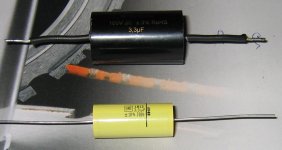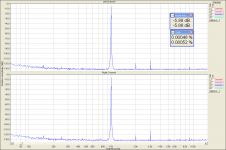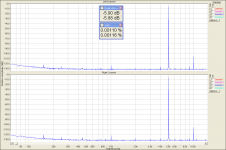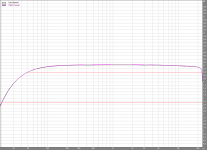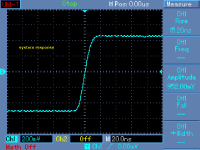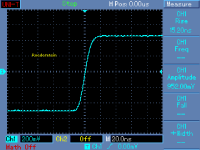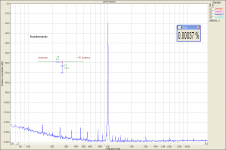Mundorf polyprop x Roederstein MKT listening test preparation
Hello all who are interested in listening comparison off different capacitors. I would like to prepare a test that would compare Mundorf MCap ZN (polypropylene)
Mundorf M-Cap Zn Tin-Foil Capacitors
with MKT polyester Roederstein ERO MKT1813
www.vishay.com/docs/26013/mkt1813.pdf
I suggest 2 test files, A and B; or possibly 3 files, where C would be one of the caps used in A or B. The sound files would be in 48kHz/24bit resolution. I would appreciate your thoughts and suggestions, like 2 or 3 files, and a kind of music used for a test. In case there are people interested in such test, I will prepare sound files with Mundorf and Rodenstein capacitors, polypropylene vs. polyester. Your thoughts are appreciated.
=====================================
Test files for download have been created
OK, here are three files. 2 of them are through same capacitor, only different recording, third file is from second capacitor.
https://www.dropbox.com/s/ce2euq2kq7v3ftz/cap1.wav
https://www.dropbox.com/s/4yjjmcef04ascag/cap2.wav
https://www.dropbox.com/s/kgeiyn17c2v4kix/cap3.wav
I would like to see:
1) an ABX result between 2 of 3 files
2) a guess which 2 of 3 files were recorded through same capacitors
3) which files are from Mundorf and which from Roederstein
Anyway, if you post your ABX screenshots according to (1) only, I will appreciate it more than enough.
Hello all who are interested in listening comparison off different capacitors. I would like to prepare a test that would compare Mundorf MCap ZN (polypropylene)
Mundorf M-Cap Zn Tin-Foil Capacitors
with MKT polyester Roederstein ERO MKT1813
www.vishay.com/docs/26013/mkt1813.pdf
I suggest 2 test files, A and B; or possibly 3 files, where C would be one of the caps used in A or B. The sound files would be in 48kHz/24bit resolution. I would appreciate your thoughts and suggestions, like 2 or 3 files, and a kind of music used for a test. In case there are people interested in such test, I will prepare sound files with Mundorf and Rodenstein capacitors, polypropylene vs. polyester. Your thoughts are appreciated.
=====================================
Test files for download have been created
OK, here are three files. 2 of them are through same capacitor, only different recording, third file is from second capacitor.
https://www.dropbox.com/s/ce2euq2kq7v3ftz/cap1.wav
https://www.dropbox.com/s/4yjjmcef04ascag/cap2.wav
https://www.dropbox.com/s/kgeiyn17c2v4kix/cap3.wav
I would like to see:
1) an ABX result between 2 of 3 files
2) a guess which 2 of 3 files were recorded through same capacitors
3) which files are from Mundorf and which from Roederstein
Anyway, if you post your ABX screenshots according to (1) only, I will appreciate it more than enough.
Attachments
Last edited:
How about:
1 Classical, 1 Rock and 1 Reggae?
For the classical I suggest Albinoni , Oboe concerto.
For rock - Telegraph road from Love over gold, Dire Straits.
Reggae - something bass heavy.
Regards
1 Classical, 1 Rock and 1 Reggae?
For the classical I suggest Albinoni , Oboe concerto.
For rock - Telegraph road from Love over gold, Dire Straits.
Reggae - something bass heavy.
Regards
Thanks for your suggestion. I will keep it, at least as music styles suggested. Later I will tell what I have available in high quality.
Are you going for fidelity or difference? Oops I see now - difference. So this is not about "high-end"!
//
//
It is also possible, as an option. In the same setup fixture, as capacitors, just a capacitor replaced by wire. Everything must remain the same, cables, length of wires, fixture. We may have only one variable to get valid data, and this would be a capacitor or capacitor replaced by wire. I have already tested the fixture with caps for distortion = distortion of whole D/A - fixture with caps - A/D. Capacitors make almost no difference, just in order of 0.00001%, when they are exchanged.
Attachments
The most common mistake by hobbiests lies in the assumption that any change will be shown in harmonic distortion tests. If any change is found to be under -70dB, it is unquestionably inaudible. What can account for a perceived change either in tonal balance or sonic signature, resides outside the scope of harmonic distortion. Is found instead within the domain of dynamic distortion.
I am not saying that everything is reflected in harmonic distortion test. I have never said that. Harmonic distortion is provided to show there is now fatal flaw in the setup.
Anyway, I would appreciate if YOU, as a professional, suggest a dynamic test. Other than oscilloscope and step response, it will be of course done, and it will show no difference. What are you suggesting, a Hirata test?
Back to the earth - we shall have some low frequency roll off. Like -2.25dB/20Hz and -0.4dB/50Hz. This will be same for both capacitors used. In fact, this measurement was done with Mundorf in left channel and Roderstein in right channel. But, it disqualifies a test with wire, IMO.
Anyway, I would appreciate if YOU, as a professional, suggest a dynamic test. Other than oscilloscope and step response, it will be of course done, and it will show no difference. What are you suggesting, a Hirata test?
Back to the earth - we shall have some low frequency roll off. Like -2.25dB/20Hz and -0.4dB/50Hz. This will be same for both capacitors used. In fact, this measurement was done with Mundorf in left channel and Roderstein in right channel. But, it disqualifies a test with wire, IMO.
Attachments
Last edited:
If any change is found to be under -70dB, it is unquestionably inaudible.
You would be surprised that this is completely wrong idea.
Hi Pavel,
May I suggest an alternative hopefully simpler methodology - that is to measure the capacitors.
Real world caps of course have an ideal capacitor with series and parallel lumped resistance and lumped inductance. This implies that the capacitor under test is a network with both series and parallel resonances that are relatively easy to identify with a frequency sweep and an accurate voltmeter or oscilloscope. Roederstein had this info on their data sheets by the way and those resonances do impinge, to an extent, on the audio spectrum. (by the way I personally suspect that manufacturers who do not publish are trying to hide low quality "stuff" with marketing spin)
Anyway, by understanding a capacitor and its parasitic elements the compromises should then be clear to an experienced technician or engineer and so aid the identification of the best fit component for your application.
My problem is that distortion measurements near the noise floor can be tenuous and inconclusive.
May I suggest an alternative hopefully simpler methodology - that is to measure the capacitors.
Real world caps of course have an ideal capacitor with series and parallel lumped resistance and lumped inductance. This implies that the capacitor under test is a network with both series and parallel resonances that are relatively easy to identify with a frequency sweep and an accurate voltmeter or oscilloscope. Roederstein had this info on their data sheets by the way and those resonances do impinge, to an extent, on the audio spectrum. (by the way I personally suspect that manufacturers who do not publish are trying to hide low quality "stuff" with marketing spin)
Anyway, by understanding a capacitor and its parasitic elements the compromises should then be clear to an experienced technician or engineer and so aid the identification of the best fit component for your application.
My problem is that distortion measurements near the noise floor can be tenuous and inconclusive.
What nominal as well as measured value are the tested capacitors?
//
Please check image in the first post, for nominal value.
I would use an RC network that allows for voltage drop across the cap... that is when the distortion will be highest. Maybe standardize at a certain voltage (1v ?) across the cap.
As a coupling cap app, the distortion will be the lowest. In a speaker XO, the distortion will be higher as there will be freq-voltage across the cap. (or any EQ/filter situation -- RIAA, etc).
Thx-RNMarsh
PS - what is the hardware and software you will be using?
As a coupling cap app, the distortion will be the lowest. In a speaker XO, the distortion will be higher as there will be freq-voltage across the cap. (or any EQ/filter situation -- RIAA, etc).
Thx-RNMarsh
PS - what is the hardware and software you will be using?
Of course. The possible distortion may appear only in case that the capacitor is heavily loaded, as in case of speaker crossover.
I have tried swept sine and step response, and it both revealed nothing. For the step response, generator with output impedance 50 ohm - capacitor - 50 ohm terminating resistor is clean and is an exact copy of the generator leading edge, 15.2 ns. All possible errors are masked by 8-bit DSO accuracy. At least, no visible resonances <20MHz.
I have tried swept sine and step response, and it both revealed nothing. For the step response, generator with output impedance 50 ohm - capacitor - 50 ohm terminating resistor is clean and is an exact copy of the generator leading edge, 15.2 ns. All possible errors are masked by 8-bit DSO accuracy. At least, no visible resonances <20MHz.
Attachments
Measurement of distortion across the cap, with cap driven trough 1k resistor, has shown nothing. Only some method residuals, anyway THD below 0.0004%. And, such situation is completely unrealistic, when the cap is used as a coupling cap. So, no other thing than good ears may help! 😉
Attachments
Thanks, whats the measured capacitance? 8 bit DSO will hardly suffice in these tests!?
Do you have a plan on if/how to vary signal level, source and sink impedance (RLC) as seen from the DUT?
How do you isolate the (varied) DUT environment but still keep the environment constant for the measurement system?
This opens up for som nasty amount of combos per DUT. What will your strategy be?
//
Do you have a plan on if/how to vary signal level, source and sink impedance (RLC) as seen from the DUT?
How do you isolate the (varied) DUT environment but still keep the environment constant for the measurement system?
This opens up for som nasty amount of combos per DUT. What will your strategy be?
//
- Status
- Not open for further replies.
- Home
- General Interest
- Everything Else
- Mundorf polyprop x Rodenstein MKT listening test preparation
